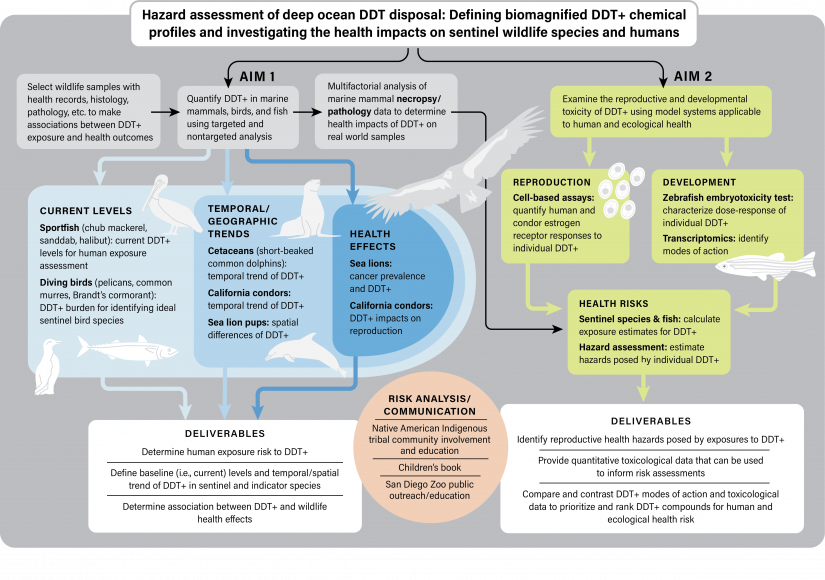
PRINCIPAL INVESTIGATORS:
Eunha Hoh (San Diego State University), Karilyn Sant (San Diego State University), Nathan Dodder (San Diego State University)
CO-PRINCIPAL INVESTIGATORS:
Rebecca Duerr (International Bird Rescue), Pádraig Duignan (The Marine Mammal Center), Alissa Deming (Pacific Marine Mammal Center), Christopher Tubbs (San Diego Zoo Wildlife Alliance); Myra Finkelstein (University of California Santa Cruz), Frances Gulland (UC Davis)
ASSOCIATE INVESTIGATORS: Margaret Stack (San Diego State University Research Foundation), Julie Skoglund (International Bird Rescue), Lian Hortensius (The Marine Mammal Center), K. Alexander Curtis (NOAA), Kerri Danil (NOAA), Nick Keller (NOAA), Sharon Melin (NOAA), Corinne Gibble (California Department of Fish and Wildlife), Caroline Moore (San Diego Zoo Wildlife Alliance), Ignacio Vilchis (San Diego Zoo Wildlife Alliance), Gabrielle Crowe (Gabrielino-Shoshone Tribal Council of Southern California), Jules Jackson (Coastal Defenders)
PROJECT ADMINISTRATOR: California Sea Grant
PROJECT SUMMARY
Relatively high levels of approximately 45 compounds related to DDT contamination (collectively referred to as DDT+) were recently identified in southern California marine animals such as dolphins, sea lions, and California condors. These chemicals could pose health risks to wildlife and humans. For example, evidence links DDT exposure to urogenital cancer in California sea lions and lower reproductive success in California condors. But there is little data on the prevalence and abundance of these contaminants in the Southern California Bight, how they distribute through biological systems, and how they directly impact animal and human health.
This study will address the lack of data in two ways. First, the researchers will use a "non-targeted” analytical approach based on specialized gas chromatography / mass spectrometry instrumentation and data processing methods to look for a broad collection of DDT+ chemicals in Bight wildlife such as short-beaked common dolphins, California sea lions, fish-eating birds, and sportfish species caught by recreational anglers. Secondly, the project will study the biological effects of DDT+ exposures (e.g., endocrine and developmental impacts) and identify the specific DDT+ compounds that are most harmful to human health and the environment.
Both study objectives will help to better understand the hazards and risks that DDT+ poses to humans and wildlife in California. The project team plans to further engage Indigenous high school students in the research project and develop a children’s book about deep ocean DDT+.
DETAILED RESEARCH OBJECTIVES:
- Determine the prevalence of approximately 45 DDT+ compounds in sentinel Southern California Bight wildlife to assess current levels, temporal trends, geographic distribution, and association with biological outcomes. Specifically, the current concentrations of 45 DDT+ compounds will be assessed in three common sportfish species (i.e., fish filets of chub mackerel, sanddab, halibut), three fish-eating bird species (i.e., livers of brown pelican, common murre, and Brandt's cormorant), and California sea lion pups foraging near DDT+ contamination sites. To explore temporal trends in DDT+ concentrations, over 30 years of archived samples from a marine mammal sentinel, the short-beaked common dolphin, (i.e., blubber samples from adult males) will be analyzed. The association of DDT+ body burdens with negative health outcomes will be explored in California sea lions (i.e., urogenital carcinoma prevalence) and in the California condor (i.e., hatching success).
- Identify and characterize the human and ecological health hazards associated with exposures to DDT+. Using laboratory tests, the endocrine disruption potential (i.e., human and condor estrogen receptor activation) and developmental toxicity (i.e., zebrafish embryotoxicity & transcriptomic response) of DDT+ compounds will be assessed.
- Quantify the relative hazards to human and ecological health associated with exposures to DDT+. With the results of Objectives 1 and 2, classic toxicological risk assessment frameworks will allow for prioritization of DDT+ compound(s) of concern based upon hazard.